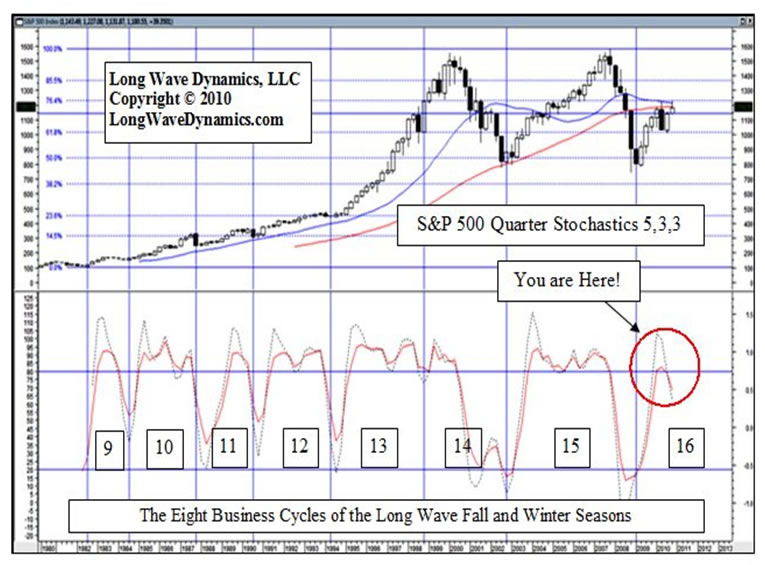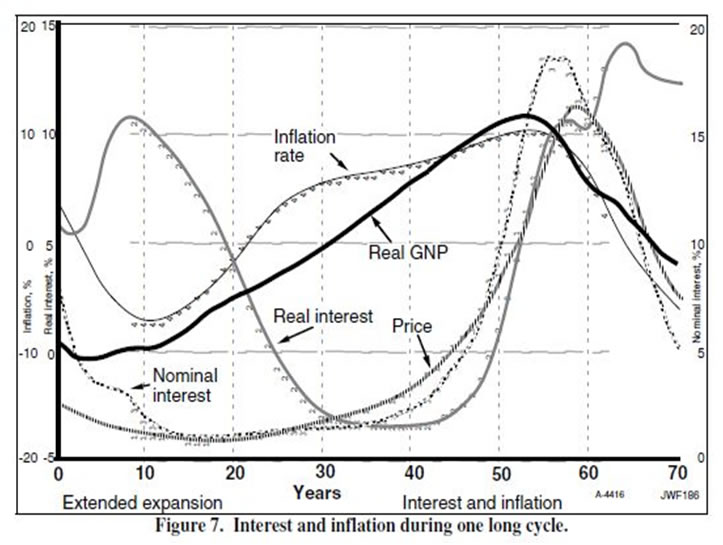Stock Market Cycles, Virtuous Circles and Trillions of Dollars
Stock-Markets / Cycles Analysis Dec 05, 2010 - 04:24 AM GMT The op-ed in the Washington Post a few weeks back by Federal Reserve Chairman Bernanke contained a few interesting revelations. Bernanke came clean on what he is doing, or at least trying to do with the trillions of dollars he has been passing out to the world’s needy that show up with tin cup in hand on the steps of the Federal Reserve System. Of course, Uncle Sam is the neediest of them all. The job description for the Federal Reserve includes delivering both 1) price stability and 2) maximum employment. Based on this dual mandate, Bernanke appears to have concluded that the Federal Reserve’s current priority is to use quantitative easing to stamp out business and stock market cycles.
The op-ed in the Washington Post a few weeks back by Federal Reserve Chairman Bernanke contained a few interesting revelations. Bernanke came clean on what he is doing, or at least trying to do with the trillions of dollars he has been passing out to the world’s needy that show up with tin cup in hand on the steps of the Federal Reserve System. Of course, Uncle Sam is the neediest of them all. The job description for the Federal Reserve includes delivering both 1) price stability and 2) maximum employment. Based on this dual mandate, Bernanke appears to have concluded that the Federal Reserve’s current priority is to use quantitative easing to stamp out business and stock market cycles.
Chairman Bernanke recognizes the deflationary forces at work in the global economy, so his primary interest trying to generate jobs and not worrying about the inflation side of things for now. In case you missed it, Bernanke wrote the following regarding quantitative easing in the op-ed, “This approach eased financial conditions in the past and, so far, looks to be effective again. Stock prices rose and long-term interest rates fell when investors began to anticipate the most recent action. Easier financial conditions will promote economic growth. For example, lower mortgage rates will make housing more affordable and allow more homeowners to refinance. Lower corporate bond rates will encourage investment. And higher stock prices will boost consumer wealth and help increase confidence, which can also spur spending. Increased spending will lead to higher incomes and profits that, in a virtuous circle, will further support economic expansion.”
The problem here is not really with the Chairman’s interpretation of the Federal Reserve’s job description, but with the knuckleheads that wrote his job description in the first place, and that would be Congress. The fact of the matter is that business cycles and stock market cycles are natural phenomena. They serve the vital function of rewarding success and punishing failure. In this natural cyclical process, prices and employment fluctuate.
The notion of Bernanke’s goal of triggering a “virtuous circle” is intriguing. Our suspicion is that it goes a long way toward explaining the extremes of business and stock market cycles of boom and bust. It appear to be the growing suspicion of many that spending trillions in taxpayer backed funds to try to produce a “virtuous circle”, or any other kind of circle for that matter, may not be the best approach to monetary policy and taxpayer resources. Typically, once you recognize you are trapped in circular reasoning, looking for the most discreet exit is advisable. However, based on the job description given to the Federal Reserve, circular reasoning could be a justified pursuit of such a “virtuous circle” on the taxpayers’ dime.
Since monetary policy swings from the pursuit of price stability to maximum employment, the world gets longer recurring business cycles and stock market cycles that reach greater heights of ecstasy and plunge to greater depths of despair than they otherwise would. Invariably, by trying to keep stock markets orbiting in a “virtuous circle” around a global economy of spending, income and profits, either prices leave orbit and fly off into space, or maximum employment crashes to earth, and voila, you have the gut wrenching business cycle and stock market cycle to boot.
The Long Wave Dynamics approach to stock market cycle and business cycle analysis views business cycles and stock market cycles as natural forces, a bit like gravity. They serve the purpose of knocking the dead and unproductive branches of business down, which serve as fuel for the fire of the next expansion. What is unnatural are the extremes to which cycles are driven by monetary and fiscal policy run amuck. When dead branches receive artificial support, they invariable fall down in time and hit someone in the head.
Pursuit of the “virtuous circle” simply makes business cycles run longer and than they would if the Federal Reserve focused only on price stability. Stock prices also tend to swing more than they would in a business cycle that did not experience the flow of trillions of dollars in taxpayer-backstopped funds distributed at the discretion of central bankers instead of business and market participants with their own skin in the game. The chart below demonstrates the stock market cycles since the bull market began in 1982, and how the business cycles have grown due to aggressive monetary policy that is trying to stop the natural decline of the cycles.

The cycles have simply grown into longer monsters. The downside of trying to generate “virtuous circles” with monetary policy is evident with business cycles and stock market cycles, but becomes even more evident with long waves. Business cycles and the smaller stock market cycles are the building blocks of long waves. Long Wave Dynamics research has discovered that there are 16 market cycles in every long wave.
Federal Reserve policy to stamp out the business cycle eventually accumulates with even greater cyclical consequences. Jay Forrester, who built the first super computer for the Navy and founded System Dynamics at MIT, recognized monetary policy pursuit of “virtuous circles” produces elongated business cycles. Considering what Forrester had to say about such matters in a speech in 2003, “By holding down bank interest and allowing inflation, especially inflation in asset values such as equities and real estate, the monetary authority maintains a low real interest during the long wave expansion. Low real interest encourages business to borrow and expand, encourages increase in asset prices, but also discourages household saving. As a result of more loans and less saving, the monetary authority must make available expanding credit to hold down the bank interest rate.”

Forrester even demonstrated this building cyclical response to stimulus with a computer simulation. “Figure 7 is a computer simulation over a cycle of the long wave for a model without growth in population or technology. It shows the very low, even negative, real interest during the expansion phase of real GNP. But, as the peak is approached, debt becomes burdensome, production capacity outruns demand, and competition drives down prices. Inflation becomes deflation, meaning negative inflation, causing a rise in real interest.”
Forrester recognizes what no central banker pursing virtuous circles can ever admit, “At the peak of the long wave, capital plant is excessive and real interest rate has risen, which together make additional investment unattractive and drive down new capital spending.” Where would we be today if the central banks of the world had paid attention to Forrester in 2003, instead of fueling the housing bubble? Now, instead of a virtuous circle, the long wave is in its vicious spiral downwards and the Federal Reserve is trying to work the magic one more time.
Attempting to create virtuous circles does not eliminate business cycles, but only makes them run longer, with bigger booms and bigger busts. Consider Forrester’s warning in 2003, “Peaks of the long wave are often considered to be some 50 years apart. However, about 70 years have now elapsed since the Great Depression of the 1930s. An explanation appears to lie in some simulations we have made in which an aggressively liberal monetary policy was introduced a decade before the peak would have otherwise occurred. It appears that expansive credit, as we have had in the United States, can extend the peak and delay the downturn for two decades or more.” Now here we are, sinking into the long wave abyss, just as forecasted.
The takeaway here is that aggressive monetary policy just expands the cycles and puts off the inevitable. The global economy is now in the grips of a Kondratieff long wave winter season. Once again, the Federal Reserve is trying to create a “virtuous circle.” The housing bubble was one of those virtuous circles that became a vicious death spiral; the results this time around will not be virtuous.
The real question here is whether the Federal Reserve should just focus on prices, or possibly only enforcing bank regulation, especially higher capital requirements, reasonable down payments, and no liar loans. Business cycles and stock market cycles are natural events that serve to reallocate capital and separate the winners from the losers. The Federal Reserve should not be messing with Mother Nature.
How should this knowledge of cycles running longer affect the decision making of investors and traders? Long Wave Dynamics has discovered the natural lengths of stock market cycles. Research is producing actionable information for investors and traders on market cycles in price and time. The long wave contains sixteen business cycles. Every business cycle (aka Kitchin cycle) contains nine Wall cycles (aka 20-Week cycle). Cycles are rarely their natural or “ideal” lengths, like market prices they are guided by Fibonacci ratios. Cycles running longer than their natural lengths are to be expected as long as central bankers are pursing virtuous circles. Tracking the Wall cycle and the Fibonacci ratio targets to tops and bottoms is essential for all serious investors and traders.
Privatizing profits and socializing losses needs to be an activity that is prohibited by the Federal Reserve System. The Federal Reserve System should be insuring that free markets reward hard work, savings and success, instead of chasing “virtuous circles” that produce bubbles, punish prudence, and reward folly, when business cycles are past their prime and should be permitted a dignified death so new life can begin in the global economy. If the Federal Reserve focuses on those worthwhile goals, natural capital formation will be available for the great ideas of the coming long wave boom. Meanwhile, investors are rushing to protect their capital from the inevitable death spiral that will follow the latest “virtuous circle”.
David Knox Barker is a long wave analyst, technical market analyst, world-systems analyst and author of Jubilee on Wall Street; An Optimistic Look at the Global Financial Crash, Updated and Expanded Edition (2009). He is the founder of LongWaveDynamics.com, and the publisher and editor of The Long Wave Dynamics Letter and the LWD Weekly Update Blog. Barker has studied and researched the Kondratieff long wave “Jubilee” cycle for over 25 years. He is one of the world’s foremost experts on the economic long wave. Barker was also founder and CEO for ten years from 1997 to 2007 of a successful life sciences research and marketing services company, serving a majority of the top 20 global life science companies. Barker holds a bachelor’s degree in finance and a master’s degree in political science. He enjoys reading, running and discussing big ideas with family and friends.
© 2010 Copyright David Knox Barker - All Rights Reserved Disclaimer: The above is a matter of opinion provided for general information purposes only and is not intended as investment advice. Information and analysis above are derived from sources and utilising methods believed to be reliable, but we cannot accept responsibility for any losses you may incur as a result of this analysis. Individuals should consult with their personal financial advisors.
© 2005-2022 http://www.MarketOracle.co.uk - The Market Oracle is a FREE Daily Financial Markets Analysis & Forecasting online publication.



